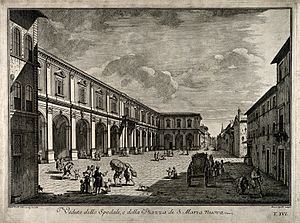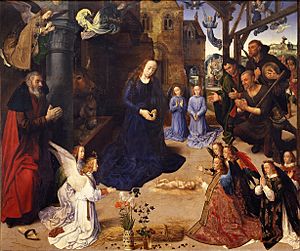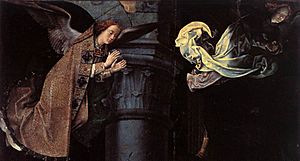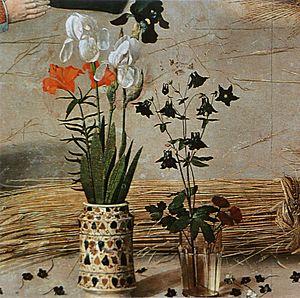Portinari Altarpiece facts for kids
Quick facts for kids Portinari Altarpiece |
|
|---|---|
 |
|
| Artist | Hugo van der Goes |
| Year | 1475-1476 |
| Medium | Oil on wood |
| Location | Uffizi Gallery, Florence |
The Portinari Altarpiece (also called the Portinari Triptych) is a famous painting from around 1475. It was created by a Flemish artist named Hugo van der Goes. This artwork is a triptych, which means it has three panels. It was ordered by a rich banker named Tommaso Portinari.
The painting shows the Adoration of the Shepherds, a scene from the Bible where shepherds visit baby Jesus. It is a very large painting, measuring about 253 x 304 centimeters. Today, you can see it at the Galleria degli Uffizi in Florence, Italy. This altarpiece is full of people and special religious symbols. Many art experts say it is one of the most studied Flemish paintings from the late 1400s.
Contents
History of the Painting
This amazing artwork was made for a church inside one of the biggest hospitals in Florence, called the hospital of Santa Maria Nuova. An Italian banker, Tommaso Portinari, asked for the painting to be made. His family had actually founded the hospital.
Tommaso Portinari lived in Bruges for over 40 years. He worked there as a representative for the powerful Medici family's bank. In the painting, you can see Portinari himself on the left panel with his two sons, Antonio and Pigello. His wife, Maria di Francesco Baroncelli, is on the right panel with their daughter, Margarita.
Each family member, except Pigello, is shown with their special patron saint. For example, Saint Thomas is with Tommaso, and Mary Magdalen is with Maria.
When the painting arrived in Florence in 1483, it was placed in the Portinari family chapel. Italian artists who saw it loved it very much. Many tried to paint in a similar style. A good example is the Adoration of the Shepherds (1485) by Domenico Ghirlandaio. He painted it for the Sassetti Chapel in Florence.
The Person Who Ordered the Painting
The hospital of Santa Maria Nuova, where the altarpiece was first kept, was built in 1285 by Folco Portinari. It started with only 12 beds. By the 1400s, it had grown to about 200 beds! Because it was so big and important, the hospital became famous in Florence and other European cities.
The hospital was built to help people, but it also brought honor to the Portinari family. Ordering the Portinari Altarpiece happened when Tommaso Portinari was at the height of his career in Bruges, around the 1470s. The huge size of the altarpiece and the choice of such a skilled artist showed how rich and powerful Tommaso Portinari was.
What the Painting Shows
In the middle part of the painting, three shepherds are kneeling in front of the baby Jesus. Van der Goes painted these shepherds very realistically, showing their rough clothes and faces. Angels are kneeling around the Virgin Mary and the Child. Baby Jesus is not in a crib. Instead, he lies on the ground, surrounded by a bright aureole of golden light. This unusual way of showing Jesus's birth might come from the visions of Saint Bridget of Sweden.
In the background of the painting, van der Goes included other scenes related to the main story. On the left panel, you can see Joseph and Mary traveling to Bethlehem. In the central panel, to the right, angels are visiting the shepherds. On the right panel, the Three Magi are on their way to Bethlehem.
Hugo van der Goes used a technique called "continuous narrative." This means he showed the same characters more than once in the same painting to tell a story over time. For example, in the central panel, the shepherds are first seen in the background with an angel above them. This is when the angel tells them about Christ's birth. Then, in the front of the central panel, the same shepherds are shown adoring Christ.
Most triptych altarpieces were usually kept closed. They would only be opened on special days, like holidays or feast days. The outside of Hugo van der Goes's triptych shows scenes of the Annunciation. This is when the Angel Gabriel tells the Virgin Mary that she will have a baby.
The artist painted the Virgin Mary and the Angel Gabriel in grisaille. This is a special style of painting that makes the figures look like sculptures, using only shades of gray. The two figures are placed in shallow spaces, like niches. Painting in grisaille on the outside of altarpieces was a common tradition for artists in the Netherlands during this time. This tradition came from the Middle Ages, when sculptures were considered the most important type of religious art.
It was cheaper for someone ordering a painting to have an artist like Hugo van der Goes who could make a painting look like a sculpture. This way, they only had to hire one artist instead of many different craftspeople. It also helped Van der Goes because he and his assistants could do the whole job. Another popular idea was to show the Annunciation scene on the outside of the triptych. The main story from Christ's life would be inside, seen when the panels were opened. This is because the Annunciation was the beginning of Christ's story.
Hidden Meanings and Symbols
The Portinari Altarpiece is known for having some of the most complex and hidden symbols in any painting of the Nativity from the 1400s. The main scenes of the Nativity and the Adoration of the Shepherds are in the central panels. In the background, on the right side, you can see the Annunciation of the Shepherds.
Many symbols in the painting represent the Eucharist, which is a holy ceremony in Christianity. The angels in the central panel are wearing special clothes called liturgical vestments. These are the same clothes worn by ministers during an important church service called a Solemn High Mass.
For example, in the upper left and lower right parts of the central panel, two angels wear a liturgical cope. This is a cloak worn by a high-ranking priest in a Solemn High Mass. Two angels on the right side of the kneeling angel wear a Dalmatic cope. This is a short-sleeved garment worn by a Deacon or Subdeacon in a Solemn High Mass.
Underneath these vestments, every assistant minister in a Solemn High Mass wears a linen alb. All the angels in the painting also wear this same linen alb. The angel kneeling at the bottom left wears a linen alb and a stole. The angel behind him wears only the alb.
These special clothes worn by the angels, along with a sheaf of wheat in the central panel, symbolize the Eucharist. The angels' clothing reminds anyone looking at the altarpiece of the holy sacrament that would take place at the altar, where the painting was placed.
There is one angel above the ox and donkey that wears very dark robes, almost like a shadow. This angel might represent the presence and threat of Satan. This dark angel seems to be flying away because Christ has arrived, symbolizing how Christ will defeat all sin. It could also show how Satan is always tempting people, making Christ's future sacrifice necessary. However, this angel's hands are joined in prayer, and he is bowing respectfully. This makes his meaning a bit unclear, perhaps on purpose.
Two structures in the painting symbolize the end of the Old Testament when Christ arrives. The old shed on the right and the Romanesque architecture building on the left are both falling apart. The column near the shed is thought to have supported Mary when she gave birth.
The ox and donkey also have religious meanings. The ox represents the Church, which accepted Christ. Its head is raised, showing it recognizes Christ. The donkey's head is tilted downward. This represents how people who worshipped in the Jewish Synagogue were "blind" to Christ.
Joseph, Mary's husband, is dressed in a red robe. In front of Joseph, and behind the white-cloaked angels, you can see a clog or sandal. This sandal symbolizes taking off your shoes before entering a holy place or stepping on sacred ground. So, the ground where Joseph is standing, and where the Christ child lies, is considered holy.
The flowers in the front of the painting also have special meanings.
- Scarlet lilies and white and purple irises represent the Passion (Christ's suffering).
- Violets stand for humility.
- Three red carnations symbolize the three nails used on the cross.
- Columbines represent the Holy Spirit.
These flowers are held in an albarello lusterware ceramic jar. This type of jar was often used by an apothecary (like an old-fashioned pharmacist) to store herbs, spices, and other natural compounds used for medicine. All the flowers mentioned, like the iris, lily, columbine, carnation, and violet, actually have medicinal properties.
See also
 In Spanish: Tríptico Portinari para niños
In Spanish: Tríptico Portinari para niños






